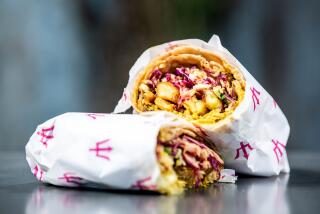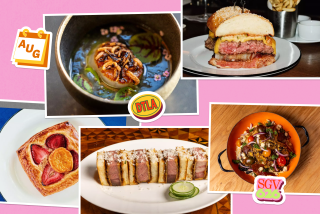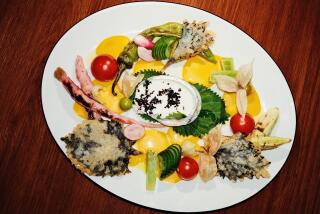Paradise down the street
NOT so long ago, just a few years in fact, America seemed determined to rid itself of all remaining traces of one of its most extravagant lapses in taste. But those who were out to cleanse the landscape of the last of “Tiki” style didn’t count on the likes of Sven Kirsten, “Bamboo Ben,” Kevin Bullat or Jeff “Biff” Butler.
Paradise, you see, doesn’t always answer to fashion. Sometimes, our earthly fantasies of paradise lead in another direction entirely.
So you stand in the mood-lit living room of Butler’s suburban tract home and behold a molded concrete Tiki that bulges out of his fireplace like a colossal potbellied stove almost as tall as you are. With glowing red eyes the size of taillights, the Tiki breathes fire from its mouth. Intermittently, gouts of steam snort from its nose.
The centerpiece of a fanciful room in which Atomic lounge meets Universal Studios, this, you say to yourself, is why Tiki style survived after all.
It’s a worldly matter: establishing a world apart from the world outside.
Mr. Butler, a mai tai, if you please.
Escapist to the extreme, Polynesian pop caught on in California and spread across the country more than half a century ago as a mild, rum-and-luau rebellion against conformity. Then, people sobered up. Tiki bars, Tiki bowling alleys and Tiki motels fell to the wrecking ball. Backyards were cleaned of those old fishing nets with cork floats and bamboo torches. Few people gave a nostalgic thought to the lacquered puffer-fish lamp that used to decorate the den or the abalone-shell ashtrays that Grandpa used to snuff out his unfiltered Pall Malls.
But tropical dreams have proved more durable than other flights of stylistic fancy. Today, perhaps to the surprise of people who don’t accept Picasso’s maxim that “taste is the enemy of creativeness,” the Tiki bar, the Tiki totem, the Tiki mug and Tiki decor have staged an exuberant comeback. Evidence of rising interest in things Tiki can be found in most states, but California remains, as one might expect, the center of mainland energy.
THREE close-by houses in different Orange County neighborhoods offer a glimpse at the stylistic possibilities that occur when people decide to stay home and let their imaginations do the long-distance traveling.
At a bend on a stolid suburban street in Westminster, a low-slung rancher looks something like Grandma’s house. In fact, this was Butler’s grandparents’ home -- a gently aging house distinguished from all the others only by a lime-green Tiki face painted over the garage door.
But cross the threshold and Grandma no longer comes to mind.
“It’s like a sanctuary to me. It puts my mind at ease. It’s my escape from normality,” says Butler of his wildly rendered retro-lounge Tiki decor.
The overlapping spirit of post-War Modernism and tropical primitive remains a distinct offshoot of Tiki style. A graphic artist, Butler’s rendition blends bold animal-print chairs with a red leather streamliner sofa and a vintage tucked-Naugahyde cocktail bar, along with Tiki stools and decorative art including primitive carvings and vivid midcentury lounge prints by artist Josh Agle, better known as Shag.
To effectively seal Butler’s domain from the elsewhere, sliding glass doors have been replaced with wood and painted, like the rest of the room, to resemble a fortress of red stone. Noon could be midnight, or the other way around, in this far-out realm beyond the comprehension of Mapquest and out of reach of Google’s satellite imagery.
Through the sliding doors lays Butler’s bedroom in which a pair of 8-foot tall, illuminated faux-stone Tikis loom as if on sentry duty for “Raiders of the Lost Ark.” A Murphy bed is tucked out of sight, opening up the visual space and highlighting the mysterious warmth of Polynesian thatch walls, crown molding of bamboo poles and a skylight filtered by tropical matting.
Butler’s father scrounged many of the furnishings at swap meets. Friends helped with the work. A one-time roommate, an unemployed artist, paid the rent with a knowing paintbrush.
Butler reaches for words. “Tiki is used in art as a reminder of our primitive side. Hot rodders use it symbolically. For surfers, it reminds them of Hawaii. There’s mysticism to it, and it’s theme park-ish.... The Tiki Room was always my favorite place at Disneyland. I guess I was looking for a place that would blow your mind, where I could entertain my friends. I’m also an artist, so I just let it go.”
Most expressions of residential decor pass in and out of style without need for social introspection. Who, for instance, will challenge your taste for stainless-steel minimalism? Or your doily Victorian furniture? Tiki proves the exception. It seems to demand questions. Why Tiki? Why now? A culture with Calvinist leanings, it seems, must answer for its frolics.
In the years following World War II, the boom seemed easy to explain. As Sven Kirsten put it in his social history and visual celebration of Polynesian pop, “The Book of Tiki,” the man in the 1950s gray flannel suit and the woman trussed tight in her girdle yearned “to cut loose and have fun in an otherwise conservative society.” In the context of the age, Tiki style was a bid for freedom -- a stage show in which one could flaunt convention and pretend to be a little naughty.
Donn Beach of Don the Beachcomber and Victor Bergeron of Trader Vic’s Americanized, and standardized, the escapist Tiki style that became the rage in backyards, dens and living rooms of the postwar era. Lavish Tiki-themed restaurant-bars spread across the country, as did aloha shirts, muumuus and torchlight luaus at home.
Polynesian pop fed off of Thor Heyerdahl’s adventure aboard the raft “Kon-Tiki” and the 1958 film “South Pacific.” The craze leveled off and became just another oddball part of Americana through the 1960s, growing odder, more tired and dusty as the years unfolded. The bulldozers went to work in earnest during 1980s and early 1990s. As cultural sensitivities rose, Tiki seemed evermore like a gross faux pas.
Today, Americans hardly need an excuse to go wild, if that is their desire. But as before, pure fantasy is surely at the root of the upsurge.
“My explanation for the appeal of Tiki today,” says Kirsten, “is that the information age has left us jaded by television and the media about exotic cultures, knowing now that each possible ‘paradise’ comes with its own set of complex problems.
“But this rational evolution has sped past our emotional one, and emotionally the human being still needs to believe that there is paradise on earth somewhere. With Tiki, we playfully can indulge in this need, satisfy it, even though we know it is a tongue-in-cheek game.” He should know. A cinematographer who lives the Tiki life in Silver Lake when he is not working on location, Kirsten’s 5-year-old book is widely credited for reigniting interest in Tiki here and in other nations not ordinarily under the spell of the tropics.
Today, some of the famous old Tiki establishments remain threatened, but new bars and restaurants are rising to replace them. Kirsten proudly reports that Tiki bars have popped up in cities across the mainland U.S. and Europe as well as Mexico. The first new Tiki bar in 30 years on Waikiki opened in 2002, Tiki’s Grill and Bar.
“It sometimes seems like people nowadays have forgotten how completely Tiki had disappeared, since it is so present now, as if it always was there,” Kirsten says.
Bamboo Ben knows the truth of it. It’s in his bloodline.
He is the grandson of Eli Hedley, one of the original popularizers of what was then called the California beachcomber style. Bamboo Ben, who divulges his legal name, Ben Bassham, only on his tax forms and driver’s license, followed in Hedley’s footsteps as a maker of furniture and home accessories. But tropical themes were passe when Bamboo Ben began his business in high school, so he manufactured faux stone furniture.
Then, he began selling small Tiki bars from his frontyard. He went cold calling door-to-door, offering to construct tropical touches to beach homes. He remembers the cogent advice of a decorator 16 years ago: “You’re crazy.” These days, Bamboo Ben can barely keep up with the growing appetite for tropical interiors. He has just finished transforming a new restaurant in Northern California into something resembling Disneyland’s Tiki Room, and he’s been asked to bid on another 12,000-square-foot Tiki job. He Tiki-fied, floor to ceiling, the Kentwood home of an animated film director. This week, he’s off to the most un-tropical of places, Arizona.
His own residence in Huntington Beach offers a retreat in sharp contrast to the retro-lounge decor of Butler, if no less incongruous considering the neighborhood. Only the banana tree and white ginger in the frontyard hint that Bamboo Ben, his wife, Vicki, aka “Mrs. Bamboo,” their two children and an aging dog, live differently than other residents of this townhouse development.
Their front door is a steppingstone across the ocean to the tranquil South Pacific: woven sea grass-mat floors, thatched and bamboo-trimmed walls, bamboo furniture, Tiki doors and a palapa-style canopy over the dining table. “My motto?” he says. “No white walls.” This is not the processed and engineered bamboo that is growing in popularity as a substitute for hardwood boards, but old-fashioned split-poles alongside the lush and variable textures of interconnected grass matting. The theme carries easily throughout 1,100 square feet and onto a small concrete patio, although Bamboo Ben describes himself as the “mechanic who never has time to work on his own job,” and so his eyes see a thousand unfinished details. For instance, there is no puffer-fish lamp yet.
“As a kid, my playground was my grandfather’s shop,” he recalls. There, Bamboo Ben learned the lesson. “You can create a permanent vacation at home. If you do it right, you don’t have to go anywhere. Relax. Instead of heading to Hawaii, stay here. Save money, save gas.”
LOCATED roughly midway between Bamboo Ben’s residence and Butler’s, Kevin and Debbie Bullat have created another spirited expression of Tiki home life, or more accurately, expressions -- plural.
In the early 1980s before they were married, their dates often took them to Kelbo’s Tiki bar on Fairfax in Los Angeles, a landmark since vanished. Tiki style rubbed off indelibly on the couple. But as sometimes happens in these matters, the two brought home different interpretations of the theme.
Today, Debbie’s tastes command the main portions of their contemporary Huntington Beach house -- calm, understated vintage Hawaiian in cool coconut whites and dark, koa wood. Her careful collections of island ceramics, carved perfume bottles, kava bowls, cruise-line menus and more are contained so as not to clutter the airy high-ceilinged living room or the rooms leading from it.
Kevin’s madness dwells in the garage, which he transformed into an extravagant, grass-mat, kitsch-clutter of rampant Tiki: rows of mugs, puffer-fish lamps -- “got to, it’s mandatory” -- fishing floats in nets, rattan furniture in bright tropical prints, carved Tiki totems, Tiki masks, Tiki signs, and of course, the centerpiece thatch-and-bamboo Tiki bar. Hardly a square inch of the walls and only part of the two-car floor space is empty of bric-a-brac drawn from the vast well of Polynesian pop.
Studying for a second career as a schoolteacher, Kevin Bullat cheerfully acknowledges that he has followed Tiki around the bend, and then some. His tattoos are Polynesian. Using the Web, he decreed the second Saturday of August as “International Tiki Day,” as if adherents really needed another excuse to party. He long ago gave up his rock ‘n’ roll band and now plays steel guitar and performs the music of old Hawaii with his group, the Smokin’ Menehunes.
“It’s kind of like an addiction, it builds on itself,” Bullat says with a grin.
Naturally. That’s the thing about fun. A little hardly seems enough. And way too much is just about right.
John Balzar can be reached at [email protected].
*
(BEGIN TEXT OF INFOBOX)
Catching the Tiki bug
Tropical Tiki style is no longer as rare as it once was. Here are some places to serve as starting points:
*
The stuff
Oceanic Arts: Founders LeRoy Schmaltz and Bob van Oosting rent Tiki props for home parties and Hollywood movies from a warehouse-size building in Whittier. They sell the raw materials to contractors and do-it-yourselfers -- bamboo, thatch, matting, as well as party supplies, faux hula skirts, nautical antiques and an array of Schmaltz’s famous Polynesian carved Tikis, masks and paddles. Also, puffer-fish lamps -- in several sizes. The company is celebrating its 50th year. 12414 Whittier Blvd., Whittier. (562) 698-6960.
Bamboo Ben: From Tiki-style lemonade stands for the kids to 12,000-square-foot commercial installations, Ben Bassham designs and builds them all himself. His retail shop is open on weekends or by appointment. 712 Yorktown Ave., No. 20, Huntington Beach. (714) 960-1860.
Starlite Room: The place to go for vintage Tiki accessories from the 1950s, ‘60s and ‘70s -- mugs, hula girl “nodders,” figurines, souvenirs, wall hangings, some rattan furniture. 2220 E. 4th St., Long Beach. (562) 434-3726.
Mixed-media
Tiki Central, at www.tikiroom.com: With more than 200,000 posts in 10 categories, this is the daily luau for those who have caught the bug. Here is the latest on carving, collecting, events, sightings, sounds, food and drink.
“The Book of Tiki” (Taschen, 2000): Sven Kirsten’s history and visual celebration of all things Tiki has inspired many. The author is highly regarded by experts for his research, his reach and his sober enthusiasm. A reduced, small-format edition has been published under the title “Tiki Style.” A sequel, “Tiki Modern,” is forthcoming.
Taboo! Tiki Index, at www.konakai.com: A staggering array of Tiki links from tattoo artists to the best of the world’s Tiki lounges, and much more.
www.roadsidepeek.com/tiki: A gallery of surviving Tiki-themed restaurant and apartment complexes throughout the Southland, from the Outrigger Apartments in Temple City to the Bahooka Restaurant in Rosemead.
Tiki Magazine: A glossy start-up launched a year ago by San Diego schoolteacher Nick Camara, this periodical circulates in 45 states and 15 countries. Camara covers a broad tropical waterfront from music to art to a current who’s-who of Tiki. His advertisers hint at just how widely Tiki is spreading. “Everything today is so hectic, so expensive. Tiki basically takes you away from all that, at least for a while,” says Camara. www.tikimag.net.
-- John Balzar
More to Read
Sign up for The Wild
We’ll help you find the best places to hike, bike and run, as well as the perfect silent spots for meditation and yoga.
You may occasionally receive promotional content from the Los Angeles Times.






